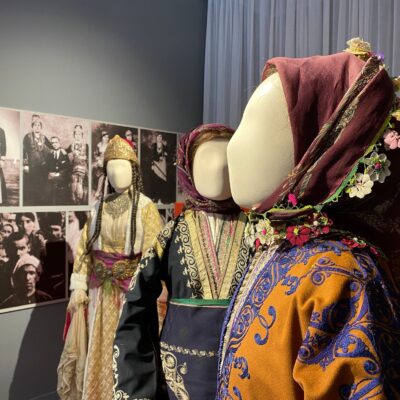
Events 03.10.2022
24.06.2021
costume exhibitionfashion and musictextile museum
Museo del Tessuto di Prato stages a major exhibition, originated of an amazing discovery
The exhibition Turandot and the Fantastic East of Puccini, Chini and Caramba is the result of extensive, meticulous research carried out by the Museum after the extraordinary discovery of several costumes and pieces of stage jewellery, dating back to the world premiere of Puccini’s Turandot, originating from the personal wardrobe of the great Prato-born soprano, Iva Pacetti.
This unprecedented, evocative, multidisciplinary and wide-ranging exhibition is the result of a collaboration between highly prestigious public and private Italian institutions. They contributed to this ambitious project in various ways, reconstructing the events that led to Giacomo Puccini, the great Tuscan composer, selecting Galileo Chini to create the set designs for the premiere of Turandot at Teatro alla Scala on 25 April 1926, directed by Arturo Toscanini.
The exhibition co-organiser is the Museum System of the University of Florence, of which the Museum of Anthropology and Ethnology houses a collection of over 600 eastern relics. Galileo Chini – a great exponent of Italian Liberty style – brought these artefacts back when he returned from his travels in Siam in 1913 and personally donated his collection to the Florentine museum in 1950. The exhibition features additional pieces on loan from the Ricordi Historical Archive, the Museo Teatrale alla Scala and the Teatro alla Scala Historical Documental Archive, the Uffizi Galleries – Gallery of Modern Art at Palazzo Pitti, the Fondazione Giacomo Puccini in Lucca, Sartoria Devalle in Turin, the Corbella Archive in Milan, the Society of Fine Arts in Viareggio and numerous private lenders.
It all began in the early months of 2018 when the Museum received a proposal to acquire a mysterious trunk containing assorted material from the wardrobe of the Prato-born soprano, Iva Pacetti. The research conducted by Daniela Degl’Innocenti, the museum curator, enabled the identification of two costumes and two examples of stage jewellery designed and produced by the Teatro alla Scala’s costume designer, Luigi Sapelli (aka Caramba), for the opera’s world premiere and worn by Rosa Raisa, the first soprano in history to interpret the role of the ‘Ice Princess’. Commencing with the extraordinary discovery, the exhibition traces the overall genesis of the opera and the artistic partnership between the great composer Giacomo Puccini and his friend, the artist Galileo Chini. The Maestro strongly desired to engage him as the set designer.
The exhibition itinerary commences in the Historical Textile Room, with a selection of approximately 120 objects from the Chini Collection, on loan from the Museum of Anthropology and Ethnology in Florence. The exhibition continues on the upper floor of the museum with a section dedicated to the set designs for Turandot, exploring how Chini’s experience in Siam strongly influenced the evolution of his creative and stylistic path.
The third and last room showcases the extraordinary costumes from the opera’s premiere. In fact, alongside those belonging to the protagonist owned by the Museum – displayed on a large raised platform that, for the first time in history, brings together the extraordinary parade of garments created by Caramba in 1926 – there are also 30 extraordinary costumes from the Sartoria Devalle Archive in Turin. The exhibition also features several original costume designs and pochoir prints created for the opera by the famous illustrator Filippo Brunelleschi, the artist Puccini initially appointed to the task, the original poster from the opera’s premiere and the voice and piano arrangement published by Casa Ricordi and illustrated with the famous image of Turandot created by Leopoldo Metlicovitz, one of the most iconic images of Italian opera of all time.
At the end of the itinerary, the Museum has dedicated a multimedia exhibition section to Iva Pacetti, the silent protagonist of our exhibition.